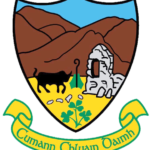Family names, as we know them, came into use in Ireland about the eleventh century. Originally they were intended to perpetuate the memory of some great man, whom his descendants were proud to claim as an ancestor. The patronymic “O” or “Mac” was prefixed to his name and the compound handed down from sire to son as a family name. Thus we get O’Neill – “descendant of (King) Niall”; MacMahon – “descendant of (King) Mahon”. Murphy is the anglicised form of MacMorrough the royal stock of Leinster, and Kelly, or more correctly O Kelly, is the modern representative of the once powerful Connacht clan, O Ceallaigh.
In many instances, family names are derived, not from the personal name of an ancestor, but from some designation bestowed on him to indicate character. For example, the Irish word “cu” which literally means “a champion”, is found in many family names and signifies “graceful” or “swift and courageous”. Thus we get Mac-Con-Uladh – “the hero of Ulster”, shortened into MacCullagh. In the same way Treanor is a shortened form of Trean-fhear, which means “a -strong man”.
Many of the old Irish family names preserve us the trade or profession of he original ancestor. Thus Clark is derived from Cleireach which means the “the clerk”. Ward is a corruption of Mac an Bhaird “son of the minstrel”, and McAteer is a shortened form of Mac an tSaor “son of the tradesman”.
Intensity of religious fervour led many Irish families to adopt as their family name that of a saint with the prefix Gil or Mul, signifying that they placed themselves specially under the care of that particular saint. Thus Malone signifies “servant of St. John”; Murray “devotee of Mary”, and MacAleenan “servant of St. Fionnáin”.
The following is a list of surnames common in the Clonduff parish together with their Gaelic equivalents:-
- ANDERSON: Mac Aindriú (son of Andrew)
- BRADY: Ó Brádaigh (spirited)
- BRANIGAN: Ó Branagáin (little raven)
- BROWN: De Brun (the brown)
- BURNS: Ó Broin (like the raven)
- CAULFIELD: Mac Cathmhaoil (son of a battle chief)
- DOYLE: Mac Dubh Gaill (black stranger)
- FAGAN: Ó Faodhagain (descended from little Hugh)
- FITZPATRICK: (Mac Giolla Phádraig (client of St. Patrick)
- GRANT: De Grannt (gigantic)
- GREENAN: Ó Grianáin (pleasant)
- GRIBBON: Mag Roibin (son of Robin)
- HANLON: Ó hAnnluain (a champion)
- McALINDON: Mac Giolla Fhionntáin (client of St. Fionntán)
- McAVOY: Mac Giollabhuide (yellow lad)
- McCONVILLE: Mac Conmhaoil (son of a high chief)
- McGAW: Mag Ádaimh (son of Adam)
- McGEE: Mac Aodha (son of Hugh)
- McGINNIS: Mag an Aonghuir (son of Aongus)
- McGILL: Mac an Ghoill (son of the foreigner)
- McGINN: Mag Fhinn (the fair)
- McGREEVY: Mag Riabhaigh (brindled)
- McLOUGHLIN: Mac Lachlainn (son of Lochlin)
- McPOLIN: Mac Póilin (son of little Paul)
- MORGAN: Ó Muireagáin (a sailor)
- MURNAN: Ó Murnáin (of a sea god)
- O’HAGAN: Ó hAgáin (young fellow)
- O’HARE: Ó hÍr (a champion)
- WALLS: De Bháll (from the valley)
- WILSON: Mac Liam (son of William)
Hilltown Village – The first marquis of Downshire was a man with the surname of Hill and he gave his name to both Hilltown and Hillsborough. The village of Hilltown was established in 1765 when the Marquis built a church for his tenants (and himself) to worship in. This church, though now disused, was and still is the central focus of the village being located in ‘The Square’. It is reputed that the bell on the Hilltown church was so loud that it could be heard in Hillsborough and had to be silenced as it broke many windows between Mr Hill’s two residences.
Mr Hill also established a market house and coaching inn opposite the church. These are now incorporated in the current Downshire Arms Hotel.
Before being known as Hilltown the small community living near the bridge (spanning the Bann River) at the bottom of the hill was known as ‘Eight Mile Bridge’ as it was eight Irish miles from Newry town.
Hilltown has always had and still has a proliferation of pubs – there are still seven in the main street but at one time had 12 or 13! Spirits were smuggled across the mountains from Newcastle on the coast and served the local hostelries. The smugglers route still exists today and is know as “The Brandy Pad”.
The village is currently a rapidly expanding commuter centre, with six new private housing developments since the latter part of the 1990s. It is commonly known as “The Gateway to the Mournes” and as the traveller rounds the last of “The Seven Bends” on the Newry road, heading into the village, the aptness of this nickname is all too apparent. The Kilkeel road from the village, via the “S of Spelga” is one of the most panoramic in the country! The River Bann rises above the Spelga Dam, flows in and out of it, meanders through the countryside until it reaches Lough Neagh and flows out the other side before reaching the Atlantic Ocean near Castlerock in Co Derry. Banbridge is built on the Upper Bann and Coleraine is on the Lower Bann.





